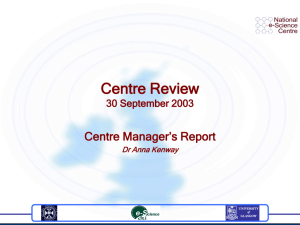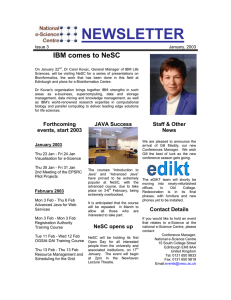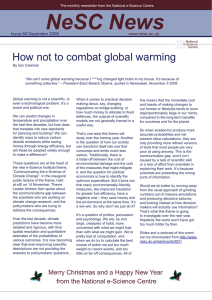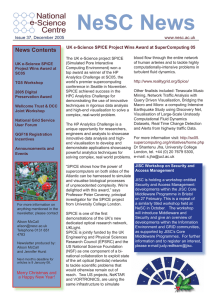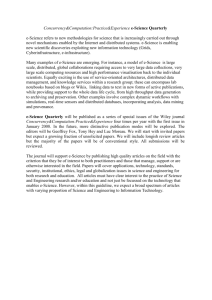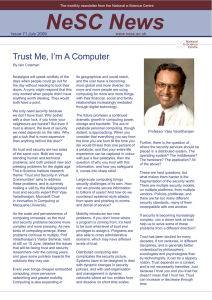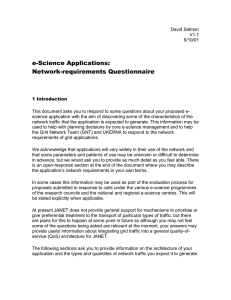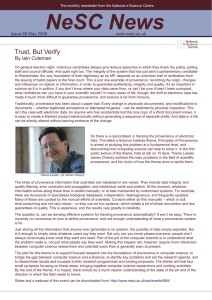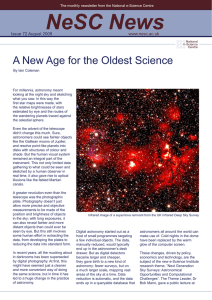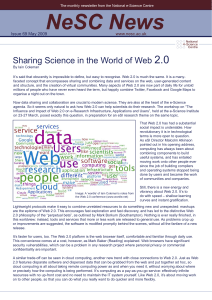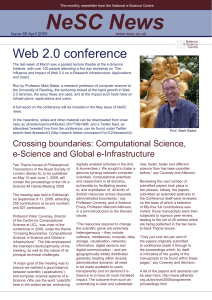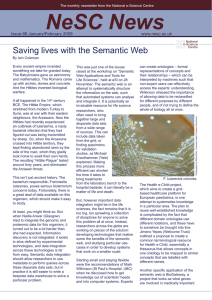NeSC News Issue 52 July 2007 www.nesc.ac.uk
advertisement
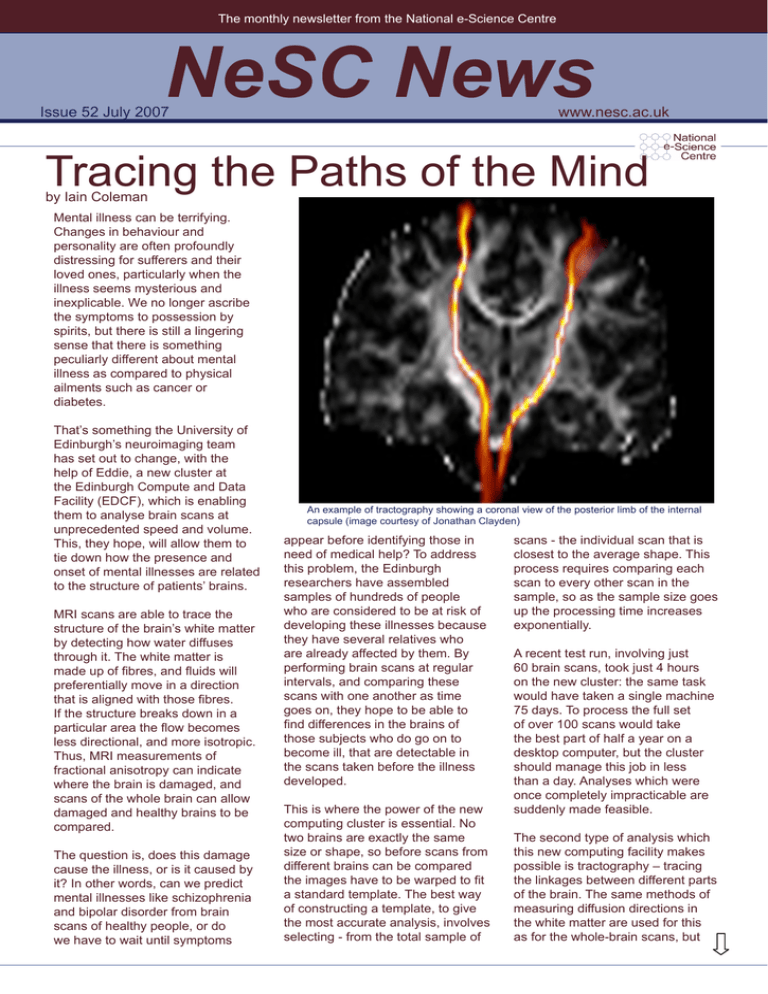
The monthly newsletter from the National e-Science Centre NeSC News Issue 52 July 2007 www.nesc.ac.uk Tracing the Paths of the Mind by Iain Coleman Mental illness can be terrifying. Changes in behaviour and personality are often profoundly distressing for sufferers and their loved ones, particularly when the illness seems mysterious and inexplicable. We no longer ascribe the symptoms to possession by spirits, but there is still a lingering sense that there is something peculiarly different about mental illness as compared to physical ailments such as cancer or diabetes. That’s something the University of Edinburgh’s neuroimaging team has set out to change, with the help of Eddie, a new cluster at the Edinburgh Compute and Data Facility (EDCF), which is enabling them to analyse brain scans at unprecedented speed and volume. This, they hope, will allow them to tie down how the presence and onset of mental illnesses are related to the structure of patients’ brains. MRI scans are able to trace the structure of the brain’s white matter by detecting how water diffuses through it. The white matter is made up of fibres, and fluids will preferentially move in a direction that is aligned with those fibres. If the structure breaks down in a particular area the flow becomes less directional, and more isotropic. Thus, MRI measurements of fractional anisotropy can indicate where the brain is damaged, and scans of the whole brain can allow damaged and healthy brains to be compared. The question is, does this damage cause the illness, or is it caused by it? In other words, can we predict mental illnesses like schizophrenia and bipolar disorder from brain scans of healthy people, or do we have to wait until symptoms An example of tractography showing a coronal view of the posterior limb of the internal capsule (image courtesy of Jonathan Clayden) appear before identifying those in need of medical help? To address this problem, the Edinburgh researchers have assembled samples of hundreds of people who are considered to be at risk of developing these illnesses because they have several relatives who are already affected by them. By performing brain scans at regular intervals, and comparing these scans with one another as time goes on, they hope to be able to find differences in the brains of those subjects who do go on to become ill, that are detectable in the scans taken before the illness developed. This is where the power of the new computing cluster is essential. No two brains are exactly the same size or shape, so before scans from different brains can be compared the images have to be warped to fit a standard template. The best way of constructing a template, to give the most accurate analysis, involves selecting - from the total sample of scans - the individual scan that is closest to the average shape. This process requires comparing each scan to every other scan in the sample, so as the sample size goes up the processing time increases exponentially. A recent test run, involving just 60 brain scans, took just 4 hours on the new cluster: the same task would have taken a single machine 75 days. To process the full set of over 100 scans would take the best part of half a year on a desktop computer, but the cluster should manage this job in less than a day. Analyses which were once completely impracticable are suddenly made feasible. The second type of analysis which this new computing facility makes possible is tractography – tracing the linkages between different parts of the brain. The same methods of measuring diffusion directions in the white matter are used for this as for the whole-brain scans, but Issue 52, July 2007 in this case sophisticated statistical modelling is applied to identify individual tracts of connecting material. This gives a whole new dimension of information about the inner workings of the brain, and gives new insights into the relationship between function and structure, allowing researchers to ask new questions about how damage relates to functional abilities. It is, however, very computing-intensive. The Edinburgh team are developing methods of comparing tracts between different patients, and are looking to compare results from tractography and whole-brain studies in the hope of new insights into the physical manifestation of mental illness. Without the new cluster, this would have been a pipe dream: now, it is within their grasp. There is tremendous potential for other data-intensive analysis on this scale, from studying strokes to researching the effects of aging, and computing clusters like Eddie may offer new hope to those touched by these debilitating afflictions. The ECDF project team involves staff from the University of Edinburgh Information Services, the National e-Science Centre and EPCC. More information about the Edinburgh Compute and Data Facility, the University of Edinburgh’s centre for enabling computation- and data-intensive research, can be found at http://www.ecdf.ed.ac.uk For more information about the Division of Psychiatry at the University of Edinburgh go to http:// www.pst.ed.ac.uk/index.html NGS User Forum The latest NGS (National Grid Service) User Forum was held on the 19-20th of June at the newly opened Oxford e-Research Centre (OeRC) at the University of Oxford. Over two days 63 participants from 20 institutions had the opportunity to meet NGS staff and to discuss the latest developments in the NGS as well as to hear how the NGS services are being used by researchers from across the UK. User presentations included Peter Coveney from UCL describing how he has used NGS resources to investigate the molecular dynamics of clay based nanoparticles and Jonathan Mitchell from the University of Leeds who explained how NGS resources are helping him model the physical properties of biomolecules. As well as applications of NGS resources, Matthew Mascord from the University of Oxford spoke about the perceived and actual barriers to the uptake of e-infrastructure to research communities. Matthew is the manager of the JISC funded e-Infrastructure Use Cases and Service Usage Models (eIUS). Presentation slides and photos from the day are available on the NGS website. Grid Computing Now events Grid Computing Now Project Manager Ian Osborne spoke at a Transport Modelling and Grid Computing workshop in London on July 12. The event brought together Transport modellers and grid computing experts, to look at ways grid can be used in transport planning for the future. GCN will also be involved in an event looking at grid applications in the medical industry, in September. Together with the London Technology Network, GCN will look at the storage and security issues raised by new medical imaging technologies. For more information on grid-related events, visit: http://grid.globalwatchonline.com/epicentric_portal/site/GRID/menuitem.0e9 a2effd1b58e9b08a38510eb3e8a0c/ NeSC News by Dr Gillian Sinclair The following day over 30 people attended a Technology Update for NGS Users Event led by Mike Mineter and Guy Warner from the NeSC Training, Outreach and Education team (TOE). The one day course included an overview of recent deployment software services on the NGS, the resource broker and the NGS portal. The next User Forum will be held at AHM 2007 as a “Birds of a Feather” meeting on the 12th of September. All current and possible future users of NGS are invited to attend. Other NGS News The NGS website (www.ngs.ac.uk) has recently been redesigned in order to make it easier for both experienced NGS users and those new to the community to find information about all aspects of the NGS. If you have any feedback regarding the new website please contact the NGS Support Desk (support@grid-support.ac.uk). The NGS has also recently appointed Gillian Sinclair as Liaison Officer who will be responsible for dissemination, publicity and outreach to communities. Gillian was previously Programme Manager for NCeSS (National Centre for e-Social Science). Photo Above: Peter Coveney from UCL at the NGS User Forum. Photo by Katie Weeks NGS. www.nesc.ac.uk Issue 52, July 2007 Scholarship 2.0 When a piece of technology is taken up by people outside the original community of users, it can be transformed as newcomers find innovative uses for its existing capabilities, and generate demand for new features never envisaged by the designers. A prime example is the explosion in tools and features for the World Wide Web, when it moved from academia into the commercial world. Something similar is happening to e-Science as it meets the arts and humanities. Scholars and artists have started working in earnest with the new tools of collaborative and distributed working that e-Science affords – and in doing so, are throwing up new challenges for technology developers. Some eye-witness accounts of this creative collision were presented last month, with the start of the summer lecture series in the eScience Institute’s “e-Science in the Arts and Humanities” theme. The first session, “Methods and Technologies for Enabling Virtual Research Communities” concentrated on ways of bringing geographically scattered scholars together to form vibrant and productive groups. Tools like AccessGrid can collapse the distance between researchers, and allow them to work together as if they were all in the same building - at least, that’s the theory. David Shepherd (Sheffield) presented results of research that showed the gap between the promise of AccessGrid and the reality. It can be tricky to manage an AccessGrid meeting such that all members have an equal chance to participate, though careful setup, attentive management and use of the jabber facility can improve the experience. When it comes to more ambitious attempts to use AccessGrid for artistic performance, considerable further development will be needed before the technology catches up with the ambitions of the artists. An emerging alternative system, the Agora multimedia collaboration e-Science Institute by Iain Coleman tool, promises to enable more fruitful scholarly collaboration in a desktop environment that combines videoconferencing, collaborative editing, and the ability to share desktops and a communal whiteboard. Adrian Fish (Lancaster) outlined the current stage of Agora’s development, and stressed its userfriendly approach. Ease of use, though, is only half the battle. Practitioners in the arts and humanities need tools that support the distinctive features of their work. Another set of lectures, “Collaborative Text Editing”, concentrated on one of the core activities of the humanities: the production of high quality critical editions of texts. The tools exist to edit and annotate texts collaboratively – the trick is to exploit these new possibilities while maintaining the integrity of more traditional scholarship. Gabriel Bodard (King’s College London) spoke about the advantages of open source critical editions. These can be much more than just texts: they can incorporate sources, supporting evidence and accounts of the methodology used in creating the edition. An edition of the Iliad, for example, could include the versions of the poem, fragments, and secondary sources that fed into this particular edition, as well as the scholar’s arguments for particular translations and interpretations. This transparency and full disclosure draws on the spirit of the open source software movement, a philosophy which corresponds closely to traditional academic practice. As soon as texts are allowed to be edited collaboratively, whether on wikis or some other environment, issues of quality control and accountability become manifest. Juan Garces (British Library) discussed the various approaches that can be taken, from anonymous peer review to community editing on the Wikipedia model. He proposed that a hybrid approach might avoid the slow response and elitism of the former, without introducing the insecurity and impermanence of the latter. He stressed that any solution has to allow the production of properly attributed, canonical texts that exist permanently and can be reliably cited. The desire to improve a work must not be allowed to supersede the need to preserve the intellectual history of a developing field. Annotation is another area where it is important to maintain the record of scholarly arguments as they develop. This is a complex information management task even when confined to traditional texts: the problems explode into whole new dimensions once you start to annotate audio and video sources as well. Jean Carletta (Edinburgh) explained how new technology is enabling this to be done, in a research project aimed at producing full records of meetings. Not just what was said, but how it was said, to whom, and what everyone else in the room was doing at the time. This is a labour-intensive, multidisciplinary project, but it should provide a rich resource for social scientists - as well as helping latecomers find out what went on before they turned up. Having developed these rich information resources, the next question is how best to share them with the rest of the world. Describing knowledge, for sharing and re-use, is what ontologies are all about, and the lecture session on “Ontologies and Semantic Interoperability for Humanities Data” sought to explore some of the aspects of ontologies that are particularly important to the humanities. The problems of multiple definitions of concepts and shifts in meaning over time, familiar to ontologists in the sciences, are even greater in the humanities, as Mark Greengrass (Sheffield) demonstrated. Our contemporary understanding of historical and cultural movements and eras can be very different from the ways NeSC News www.nesc.ac.uk Issue 52, July 2007 they were understood by those who participated in them, and the categories we apply to order our knowledge can shift radically. There is a wealth of historical material from the Eleven Years Truce, for example – but none of the people involved knew it was going to last for eleven years. The problems of creating ontologies that are useful to and trusted by practitioners in the humanities are also substantial: with a tradition of individual scholarship, and a dearth of authoritative institutions, widespread acceptance of such grand intellectual designs can be hard to achieve. Notwithstanding these difficulties, Oscar Corcho (Manchester) presented an example of how ontologies and semantic web technology can enable a shift from information retrieval to question answering. The development of an ontology of Spanish authors of the late nineteenth and early twentieth centuries – the Silver Age – is permitting scholars to develop new strategies for obtaining and combining information. While this is still a work in progress, Corcho anticipates that projects like this will impel a paradigm shift in knowledge acquisition. What all these lectures made clear is that the arts and humanities can benefit tremendously from eScience technologies, but only if the tools are suitable for their specific purposes. Scholars and performers have priorities and concerns that are often different from those of scientists and engineers. As this Theme continues, those needs and requirements should become still more sharply defined, opening up exciting new possibilities not only for the Arts and Humanities, but for e-Science itself. Material from these lectures, including webcasts and slides, can be downloaded from http://wiki.esi. ac.uk/E-Science_in_the_Arts_and_ Humanities NeSC News Register Now! Please join us at the East Midlands Conference Centre in Nottingham from 10 th-13 th September 2007. We are sure you will enjoy the conference, the exhibition and the opportunity to meet friends old and new. This year sees e-Science firmly established as an important discipline with an expanding set of practitioners. All Research Councils are engaged, and JISC is committed to transferring the results of e-Science research into everyday practice in higher education. We look forward to welcoming you to this year’s All Hands Conference which remains the key event in the e-Science calendar. We are fortunate to have an excellent set of invited speakers: The packed programme reports the latest results in e-Science as papers, posters, workshops and BoFs – plus an exhibition demonstrating practical achievements. You will also find the Provisional Programme online at http://www. allhands.org.uk/programme/index. cfm Remember to register before 1 August to ensure the lower registration rate. Grid Computing and the National Grid Service Induction e-Science Institute, Edinburgh, 26 - 27 July, 2007 This course will introduce participants to the concepts of Grid Computing and then give a practically oriented introduction to the middleware and services of the National Grid Service. FOr information, go via http://www. nesc.ac.uk/training/events/ Call for Participation: A Plenary Session on the Authentication Levels of Assurance (LoA) August 29, 2007, Manchester, UK http://www.ias07.org The event will be hosted in conjunction with the Third International Symposium on Information Assurance and Security that aims to bring together researchers, practitioners, developers, and policy makers involved in multiple disciplines of information security and assurance to exchange ideas and to learn the latest development in this important field. For more details, please visit the conference website at http:// www.ias07.org. Call for Papers Third EELA Conference Catania (Italy) 3-5 December 2007 More information can currently be found at: http://indico.eu-eela.org/ conferenceDisplay.py?confId=96 The NeSC Newsletter produced by: Alison McCall and Jennifer Hurst, email alison@nesc.ac.uk, Telephone 0131 651 4783 The deadline for the August/ September Newsletter is: 31st August 2007 www.nesc.ac.uk Issue 52, July 2007 Forthcoming Events Timetable July 23-24 AHRC ICT Methods Network Workshop on Space and Time: Methods of Geospatial Computing for Mapping the Past e-Science Institute http://www.nesc.ac.uk/esi/events/772/ 26-27 Grid Computing and the National Grid Service - Induction e-Science Institute http://www.nesc.ac.uk/esi/events/810/ 30-31 Collaborative Knowledge Extraction (CoKE): Sequencing Animal Behaviour e-Science Instiute http://www.nesc.ac.uk/esi/events/807/ 16-18 Grid and Co-operative Computing (GCC) Urumchi, Xinjiang, China http://vega.ict.ac.cn/gcc2007/ 27-28 CoreGRID Symposium IRISA, Rennes, France http://www.coregrid.net/mambo/content/view/358/330 28-31 Euro-Par 2007 IRISA, Rennes, France http://europar2007.irisa.fr/ 3-7 LAnguages, methodologies and Development tools for multi-agent systemS (LADS007) Durham, UK http://lia.deis.unibo.it/confs/lads/ 3-7 Parallel Computing Technologies Pereslavl-Zalessky, Russia 5 Distributed Programming Abstractions - Workshop II e-Science Institute http://www.nesc.ac.uk/esi/events/815/ 6-7 The Fourth International Conference on Life Science Grids 2007 (LSGrid 2007) National e-Science Centre, Glasgow http://www.nesc.ac.uk/events/ lsgrid2007/ 10 - 13 UK e-Science All Hands Meeting Registration Now Open! East Midlands Conference Centre, Nottingham http://www.allhands.org.uk/ 10 - 14 5th International GridKa School 15 HiPerGRID Brasov. Romania http://pact07.cs.tamu.edu/ 19-21 The 8th IEEE/ACM International Conference on Grid Computing (Grid 2007) Austin, Texas http://www.grid2007.org/ 20 -21 Computational Methods in Systems Biology (CMSB 2007) e-Science Institute http://www.nesc.ac.uk/esi/events/749/ 1-5 EGEE07 Conference Budapest http://www.eu-egee.org/egee07/ registration 7-9 Third International Conference on eSocial Science Ann Arbor, Michigan, US http://ess.si.umich.edu/ 22-24 PhyloInformatics Workshop e-Science Institute http://www.nesc.ac.uk/esi/events/710/ August September http://www.ssd.sscc.ru/conference/ pact2007/ http://www.fzk.de/gks07. October This is only a selection of events that are happening in the next few months. for the full listing go to the following websites: Events at the e-Science Institute: http://www.nesc.ac.uk/esi/esi.html External events: http://www.nesc.ac.uk/events/ww_events.html NeSC News If you would like to hold an e-Science event at the e-Science Institute, please contact: Conference Administrator, National e-Science Centre, 15 South College Street, Edinburgh, EH8 9AA Tel: 0131 650 9833 Fax: 0131 650 9819 Email: events@nesc.ac.uk www.nesc.ac.uk
